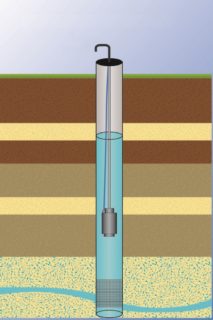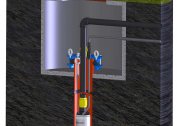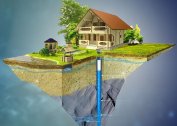Providing the site with water is the first task of its owner. The more plans to improve your site, the stronger the lack of water will be felt. Water is needed for construction work, garden, personal daily needs.
What is an aquifer
 From a scientific, geological, point of view, this term refers to various mining, the latitude of which is much less than depth. An aquifer, in the ordinary words, is a hydrotechnical recess in the earth of small diameter, prepared to take water from subsoil aquifers. In addition, they are sometimes called "pipe wells", because the walls of the wells are installed from shedding by casing pipes.
From a scientific, geological, point of view, this term refers to various mining, the latitude of which is much less than depth. An aquifer, in the ordinary words, is a hydrotechnical recess in the earth of small diameter, prepared to take water from subsoil aquifers. In addition, they are sometimes called "pipe wells", because the walls of the wells are installed from shedding by casing pipes.
Is it necessary to clean an aquifer
Water from wells, especially artesian ones, in contrast to shallow waters, is less often clogged with organic compounds, bacteria, hazardous metals and other anthropogenic pollutants.
“Permanent” wells for water supply do not exist. Unfortunately, someday the owner of a drainage well will run into difficulties. It’s not good if the aquifer is exhausted, you will need to drill again or make a deeper hole. It is difficult and extremely costly. Another thing, if contamination of the well has occurred, it is easier and cheaper to prevent it than to “repair” it.
The extension of the service life of the source will be facilitated by the fulfillment of certain conditions of use:
- Follow your preferred drilling technology exactly. Carefully observe the tightness of the casing, the integrity of the filter.
- Immediately after the completion of drilling operations, wash the source until clean water appears.
- Protect the well from the invasion of shallow waters, clogging, putting a caisson, a tip. As a temporary solution, simply plug the top of the casing.
- Prior to use, it is wise to select and place a water submersible pump at the required height without fail, given the flow rate of a water well.
- Do not use a vibrating pump to supply water. Rocking in the casing, it, depending on the type of soil, to a great or lesser extent causes sand to enter the well or will contribute to siltation of the adjacent soil. It is possible to use a cheap and conventional vibrator for a short time, a centrifugal pump is required for stable operation.
- A well is not required to stand indiscriminately. A perfect operating mode is the daily pumping out of some 10 or hundreds of liters of water. It is provided if people always live in the house. If this is unrealistic, it is necessary to constantly pump out at least 100 liters from the well at least once every 2 months. water.
Compliance with these tips, of course, will not help to eliminate well contamination in the future. But it will postpone this problem, guaranteeing the maximum possible resource for productive operation for this source.
Bring water to standards
 We will analyze the rules for bringing water to standards according to those indicators which have the most differences:
We will analyze the rules for bringing water to standards according to those indicators which have the most differences:
- Iron removal and demanganization (elimination of manganese). Often, seeing water subsequently loosening the well, people, recognizing it as being visually cleaned, begin to use it to supply their own homes without analysis in advance in the water laboratory. However, over time, a rusty and sometimes dark coating forms on the plumbing, a chestnut deposit appears in the teapot, and the water in the jar becomes white at first, and later yellowish or even brown with a black precipitate.This is all due to the iron contained in water in an unoxidized divalent soluble form. It is oxidized by air and falls in the form of a yellowish or chestnut precipitate. Such water often contains a glandular taste.
- The negative effects of iron and manganese. Iron and manganese in drinking water have a negative effect on plumbing and human health. On plumbing, a yellowish is formed, and because of manganese - a dark coating that is difficult to remove even with the most powerful cleaning products. Although iron does not show such a powerful negative effect on human health, it spoils the skin and hair. Iron compounds accumulate in the liver and eventually destroy its cells.
- Oxidation. First, oxidation should be carried out. For these purposes, apply the procedure of aeration and oxidation with atmospheric oxygen or reagent oxidation. In the form of reagents, sodium hypochlorite, hydrogen peroxide or potassium permanganate are used. Air aeration can be replaced by ozonation, especially in the presence of manganese, because ozone is considered the most powerful oxidizing agent than air. If you rarely use the well, it is possible to simply stand up the water by putting, for example, an ordinary tank in the attic of a house. Once in it, water will come into contact with the atmosphere, iron will oxidize, and a precipitate will form. The zone of water discharge from the tank must be larger than the resulting sediment.
- High rigidity and methods of resistance with it. Talking about stiffness, they most of all mean the presence of calcium ions in water. This is part of the truth. However, magnesium cations also take part in the formation of stiffness, and among the anions, mainly hydrocarbon ions. Whether your source is characterized by stiffness is easy to recognize: scum on heating devices confirms this.
Subsequently, it was recommended that the installation and start-up of the treatment plant be taken a second time to test the water and deliver it to the laboratory for research, which is not associated with the company installing the water treatment equipment. This will provide an opportunity not only to control the work of the company that provided the equipment, but also, if necessary, to adjust the operation of the purification system.


